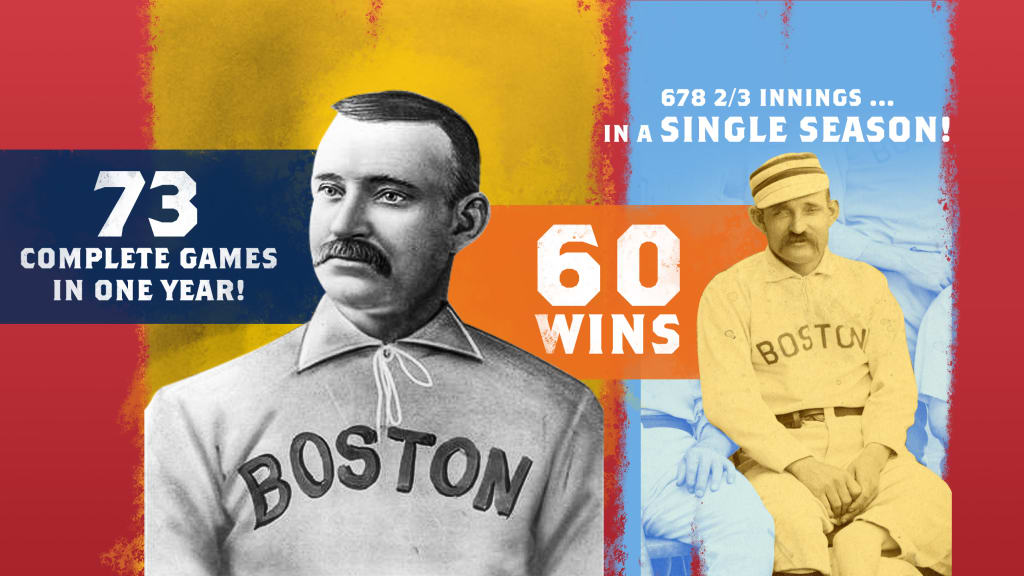
When you look at Old Hoss Radbourn's numbers, you can't believe they're real: 60 wins in a single season. Back-to-back seasons with over 600 innings pitched -- topping out at 678 2/3. Four hundred and forty one strikeouts in one summer. Surely this couldn't be baseball ... could it? And while there were several notable rule changes that happened during and after Radbourn's career that meant we would never see a pitcher like this again -- he started his career when he could throw underhand and toss from a large pitcher's "box," to name but a few -- there's a reason that his performance still astonishes us today. Nobody -- even in the 1880s -- was doing what Old Hoss did.
If you know the name already, you're either an early baseball scholar and devotee, or you know of the secretive person (or, I suppose, ghost) who runs the popular Twitter account, @OldHossRadbourn. It gave a viral voice to this irascible, irritable, old son of a gun who looked down upon modern players who wouldn't dare try to pitch 73 complete games in a single season, drinking whiskey at every step along the way. As funny as it is, it's also probably a fair summation of just who Radbourn may have been.
As we celebrate what would have been his 168th birthday, let's dive a little deeper into Old Hoss' career.
The early years
Born on Dec. 11, 1854, as Charles Gardner Radbourn (sometimes spelled "Radbourne"), he never grew up dreaming of becoming a baseball player ... because pro baseball wouldn't be invented until he was 15 years old. Instead, Radbourn -- whose family had moved to Bloomington, Ill., -- first worked as a butcher with his father and then as a brakeman for the IB&W Railroad.
Soon, his natural skills on the diamond stood out, though. He began pitching for the local Bloomington nine before moving on to play for Dubuque, Iowa, in 1879 for the whopping sum of $450 for the season. Of course, there was a little kerfuffle while he was in Bloomington, with charges that Radbourn had thrown a game in exchange for $25. True to Radbourn's ways, he admitted that while he may have agreed to the sum that night, he was also drunk and therefore "was not responsible for his words."
It's in Iowa when the legends begin -- even though he wasn't a starting pitcher just yet. According to his SABR biography, he was the team's second baseman, outfielder and change pitcher. (These were the days when you couldn't bring in a new player. So, if a pitcher tired out, you would swap him with someone else in the field.)
Radbourn once made 15 putouts in a single game while playing the keystone, and when he pitched against the Major League White Stockings in an exhibition, he completely befuddled the hitters. Cap Anson later said, "In my fifteen years as premier batsman of the game, I never faced a pitcher who baffled me more completely with his curves than did Radbourn on the occasion of that memorable game in Dubuque … I do not hesitate to say that not one of the old school pitchers, or any of the later slabmen, could equal the famous Radbourn."
He made his big league debut after signing with the Buffalo Bisons the following year. Unfortunately, an arm injury kept him from taking the mound, so he started as a position player. After going just 3-for-21 to begin the campaign, the team released him. Radbourn headed back to Bloomington, his future as a baseballer in doubt.
Providence intervenes
Radbourn may have been content to hang 'em up and work as a butcher or perhaps in a tavern as he later would. But then his friend, Bill Hunter -- presumably the same one who would play two games with Louisville in 1884 -- intervened. Hunter sent the Providence Grays a telegram in which he pretended to be Radbourn. He said that if they paid him the same amount as Buffalo had offered the year before, he would sign. So, when Providence agreed to the terms, Hunter did what any good friend would do: He accepted on Radbourn's behalf.
Having been out of baseball for a year, Radbourn wasn't ready -- or pleased -- to return to the sport. So, Hunter paid out of his own pocket for Radbourn to head to Arkansas to get in shape.
That we have any tales to tell about Radbourn today is thanks to the duplicitous and motivating Hunter. The baseball world owes him a debt of gratitude.
The rivalry
After being forced back into baseball, Radbourn quickly became a star with the Grays. He went 25-11 with a 2.43 ERA in a pedestrian (for him) 325 1/3 innings in 1881. The next year, he went 33-19 with a 2.11 ERA and a league-leading six shutouts in 466 innings. (That same year, while playing right field, Radbourn ended one of the greatest games in baseball history by smashing a walk-off home run in the 18th inning to defeat the Red Stockings, 1-0.)
1883 saw him take it to a whole new level. Radbourn went 48-25 with a 2.05 ERA in 632 1/3 innings. And then, 1884 came -- the year that Radbourn set records that no one will ever touch.
Now, plenty of rivalries in sports history have led players to new heights. There's Messi vs. Ronaldo. Michael Jordan vs. well, everybody. Randy Johnson and Curt Schilling were teammates and rivals, and their heated one-upmanship helped lead the D-backs to the 2001 World Series championship. That's apparently the kind of relationship that Radbourn had with the Grays' other starting pitcher, Charlie Sweeney.
Sweeney and Radbourn were a devastating one-two punch in the Grays' rotation in '84, with Sweeney going 17-8 with a 1.55 ERA for Providence to start the season. But Radbourn didn't like the attention Sweeney received or the amount he was paid. Unhappy on the team, things got rough that summer, with Radbourn's play beginning to suffer, too. After losing to Boston, 5-2, on July 16, the Boston Advertiser wrote, “There have been unpleasant reports of the dissatisfaction of Radbourn, pitcher of the Providence club, current for some time. This evening the board of directors of the Providence association decided to summon him to appear before them tomorrow and answer certain questions regarding his conduct for the past three weeks.”
But when Sweeney jumped to the St. Louis Maroons of the Union Association later that summer, Radbourn made an offer the Grays couldn't refuse.
“I’ll pitch every day and win the pennant for Providence," Radbourn said, "even if it costs me my right arm.”
In exchange, the Grays raised his salary, essentially giving him what Sweeney was earning, and handed him another bonus on top of that to ensure the rival league wouldn't also sway him.
From there, Radbourn had perhaps the most remarkable run in baseball history. The Grays had 51 games left that season and Radbourn started 41 of them. He won 35 games, lost four, and tied once. He won 18 straight games and basically delivered Providence to the pennant all by himself.
In the end, this is what his numbers looked like:
60-12, 1.38 ERA, 75 games, 73 complete games, 678 2/3 innings pitched, 441 strikeouts and a truly absurd 2,672 batters faced. To put that in perspective, the five pitchers on the World Series champion Braves who started the most regular-season games for the team combined to face 2,876 batters in 2021.
End of the line
Perhaps not surprisingly, this season marked the high point of Radbourn's career. Even in this era, when he could throw the ball underhand and velocity wasn't nearly what it is today, that was still a lot of mileage to put on his golden right arm.
“His showing was all the more remarkable and phenomenal when one knows that this great pitcher suffered untold agony in endeavoring to attain the goal for which he worked so hard and so pluckily," manager Frank Bancroft said. "Morning after morning upon rising he would be unable to raise his arm high enough to use his hair brush. Instead of quitting he stuck all the harder to his task, going out to the ballpark hours before the rest of the team and beginning to warm up by throwing a few feet and increasing the distance until he could finally throw the ball from the outfield to home plate.”
Radbourn remained effective, but never again would he top 600 innings. As his performance waned and his truculent (and perhaps drunken) attitude couldn't be balanced by starting almost every game, the relationship between Radbourn and the Grays soured until he left to pitch for the Boston Beaneaters, the Boston Reds and the Cincinnati Reds before retiring during the 1891 season.
He finished his career with an astonishing record of 310-194 in 4,527 1/3 innings across just 11 years -- that's an average of 412 innings per season -- with 1,830 strikeouts. Despite having finished his career 130 years ago in an era when batters didn't strike out anywhere near the rate they do today, Radbourn still ranks 113th all-time in strikeouts.
After retiring, Radbourn went back to Bloomington and did what he probably always wanted to do: He opened a tavern. He called it, simply enough, “Radbourn’s Place,” with an 1891 advertisement reading, "Best of everything in Wet Goods and Cigars; Base Ball Headquarters." (So, next time you order a drink at a bar, ask for a "wet good." Radbourn would probably like that.)
Sadly, Old Hoss wasn't long for this world. He would pass away only six years later on Feb. 5, 1897, following a hunting accident and other maladies that "lingered on from year to year as disease gnawed at his mental and physical being, robbing him of speech, feeling and locomotion long before the final day arrived."
The hero
Let's not end on a sad note for one of baseball history's most interesting characters, though. Instead, let's go back to July 12, 1892, when "Old Hoss" showed off some of that fiery courage he displayed on the mound. That evening, a man named George Fletcher brought his family into Bloomington to shop for supplies. While he went inside, Fletcher left his wife and son outside in the carriage when something spooked their horse. As the horse took off running with the carriage behind him, a man dashed out of Radbourn's Place in a white jacket "with the stride of a professional sprinter."
"[L]ike a flash, [he] was at the running horse’s head. With his right hand he seized the bit and with his left put a powerful clamp upon the horse’s nostrils. The plunging horse dragged the man along with him, and would possibly have gotten away had not the man dexterously turned him so sharply as almost to upset the buggy, thus bringing the animal suddenly almost to a standstill.”
That man in the white jacket? None other than Radbourn himself, who simply walked back into his tavern and presumably returned to pouring drinks once the action was over.
